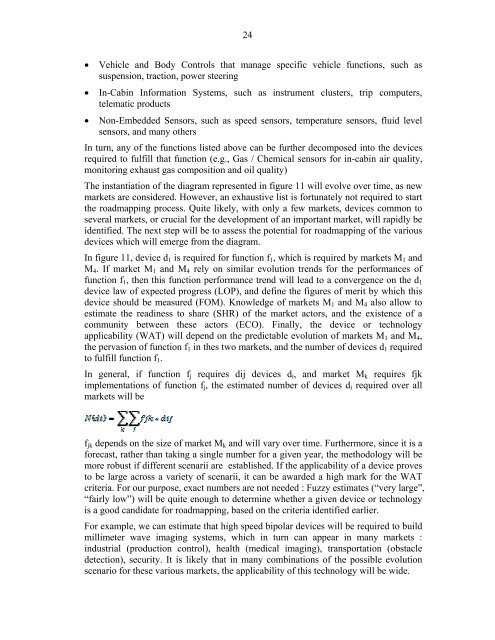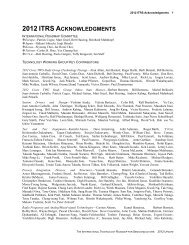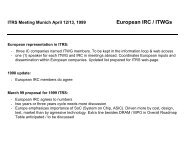More than Moore White Paper - ITRS
More than Moore White Paper - ITRS
More than Moore White Paper - ITRS
Create successful ePaper yourself
Turn your PDF publications into a flip-book with our unique Google optimized e-Paper software.
24<br />
• Vehicle and Body Controls that manage specific vehicle functions, such as<br />
suspension, traction, power steering<br />
• In-Cabin Information Systems, such as instrument clusters, trip computers,<br />
telematic products<br />
• Non-Embedded Sensors, such as speed sensors, temperature sensors, fluid level<br />
sensors, and many others<br />
In turn, any of the functions listed above can be further decomposed into the devices<br />
required to fulfill that function (e.g., Gas / Chemical sensors for in-cabin air quality,<br />
monitoring exhaust gas composition and oil quality)<br />
The instantiation of the diagram represented in figure 11 will evolve over time, as new<br />
markets are considered. However, an exhaustive list is fortunately not required to start<br />
the roadmapping process. Quite likely, with only a few markets, devices common to<br />
several markets, or crucial for the development of an important market, will rapidly be<br />
identified. The next step will be to assess the potential for roadmapping of the various<br />
devices which will emerge from the diagram.<br />
In figure 11, device d1 is required for function f1, which is required by markets M1 and<br />
M4. If market M1 and M4 rely on similar evolution trends for the performances of<br />
function f1, then this function performance trend will lead to a convergence on the d1<br />
device law of expected progress (LOP), and define the figures of merit by which this<br />
device should be measured (FOM). Knowledge of markets M1 and M4 also allow to<br />
estimate the readiness to share (SHR) of the market actors, and the existence of a<br />
community between these actors (ECO). Finally, the device or technology<br />
applicability (WAT) will depend on the predictable evolution of markets M1 and M4,<br />
the pervasion of function f1 in thes two markets, and the number of devices d1 required<br />
to fulfill function f1.<br />
In general, if function fj requires dij devices di, and market Mk requires fjk<br />
implementations of function fj, the estimated number of devices di required over all<br />
markets will be<br />
fjk depends on the size of market Mk and will vary over time. Furthermore, since it is a<br />
forecast, rather <strong>than</strong> taking a single number for a given year, the methodology will be<br />
more robust if different scenarii are established. If the applicability of a device proves<br />
to be large across a variety of scenarii, it can be awarded a high mark for the WAT<br />
criteria. For our purpose, exact numbers are not needed : Fuzzy estimates (“very large”,<br />
“fairly low”) will be quite enough to determine whether a given device or technology<br />
is a good candidate for roadmapping, based on the criteria identified earlier.<br />
For example, we can estimate that high speed bipolar devices will be required to build<br />
millimeter wave imaging systems, which in turn can appear in many markets :<br />
industrial (production control), health (medical imaging), transportation (obstacle<br />
detection), security. It is likely that in many combinations of the possible evolution<br />
scenario for these various markets, the applicability of this technology will be wide.




